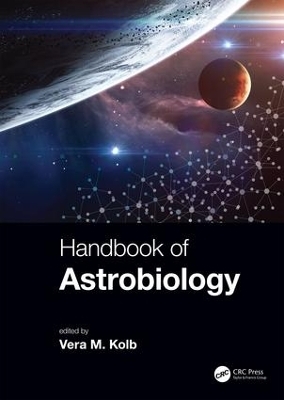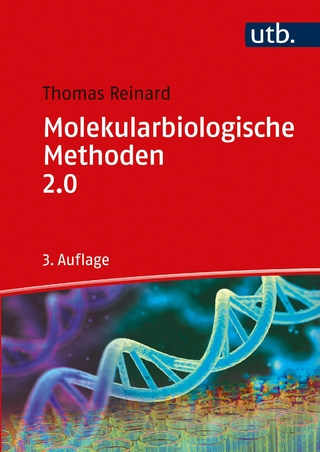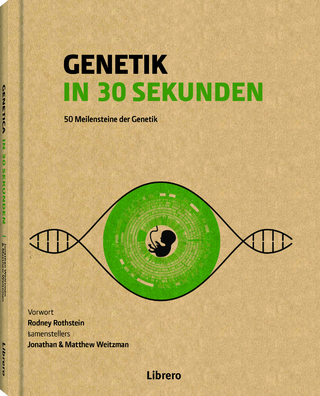
Handbook of Astrobiology
CRC Press (Verlag)
978-1-138-06512-3 (ISBN)
Astrobiology is the study of the origin, evolution, distribution, and future of life on Earth. This exciting and significant field of research also investigates the potential existence and search for extra-terrestrial life in the Solar System and beyond.
This is the first handbook in this burgeoning and interdisciplinary field. Edited by Vera Kolb, a highly respected astrobiologist, this comprehensive resource captures the history and current state of the field. Rich in information and easy to use, it assumes basic knowledge and provides answers to questions from practitioners and specialists in the field, as well as providing key references for further study.
Features:
- Fills an important gap in the market, providing a comprehensive overview of the field
- Edited by an authority in the subject, with chapters written by experts in the many diverse areas that comprise astrobiology
- Contains in-depth and broad coverage of an exciting field that will only grow in importance in the decades ahead
Vera M. Kolb earned a BS in Chemical Engineering and an MS in organic chemistry from Belgrade University, followed by a PhD in organic chemistry at Southern Illinois University at Carbondale. She was a Chemistry Professor at the University of Wisconsin-Parkside from 1985-2016, and is now a Professor Emeritus. During her first sabbatical leave (1992-1994) she received training in astrobiology (then termed exobiology) at the NASA Specialized Center of Research and Training (NSCORT) in San Diego, where she has worked with Leslie Orgel at the Salk Institute, and Stanley Miller, at the University of California San Diego. She has worked in the field of astrobiology ever since. In 1992 she received the University of Wisconsin-Parkside Award for Excellence in Research and Creative Activity. During her second sabbatical (2002-2003) she studied sugar organo-silicates and their astrobiological importance with Joseph Lambert, at Northwestern University. She was inducted in the Southeastern Wisconsin Educators' Hall of Fame in 2002. She is a recipient of numerous research and higher education grants and awards from the Wisconsin Space Grant Consortium/NASA, among others. At this time, she has published over 150 articles, including patents and books, in organic chemistry, medicinal chemistry, and astrobiology. She has edited a book "Astrobiology, An Evolutionary Approach", for CRC Press, which was published in 2014. Her second book, "Green Organic Chemistry and its Interdisciplinary Applications", was published in 2016, also by CRC Press. Since both astrobiology and green chemistry study organic reactions in water, as in the primordial soup for astrobiology and as a benign solvent in green chemistry, the relationship between these two fields speaks of their true interdisciplinary characters.
Part 1. Astrobiology: Definition, Scope, And Education
Chapter 1.1 Astrobiology: Definition and Scope
Vera M. Kolb
Chapter 1.2 Astrobiology Goals: NASA Strategy and European Roadmap
David Des Marais
Chapter 1.3 Online, Classroom and Wilderness Teaching Environments: Reaching Astrobiology Learners of All Ages Around the World
Bruce W. Fouke
Chapter 1.4 Astrobiology as A Medium for Science Education
Sun Kwok
Chapter 1.5 Astrobiology as Origins Story: Education and Inspiration Across Cultures
Daniella Scalice
Part 2. Definition and Nature of Life
Chapter 2.1 Definition of Life: Multiple Perspectives
Vera M. Kolb
Chapter 2.2 A Generalized and Universalized Definition of Life Applicable to Extraterrestrial Environments
Benton C. Clark
Chapter 2.3 Synthetic Life and Minimal Cell
Hamilton Smith, J. Craig Venter, and Clyde Hutchinson
Chapter 2.4 Communication as The Main Characteristic of Life
Guenther Witzany
Part 3. Origin of Life: History, Philosophical Aspects, And Major Developments
Chapter 3.1 Philosophical Aspects of The Origin-Of-Life Question: Neither by Chance nor By Design
Iris Fry
Chapter 3.2 Charles Darwin And the Plurality of Worlds: Are We Alone?
Michael Ruse
Chapter 3.3 Origins of Life: Early History, From Buffon To Oparin
Stephane Tirard
Part 4. Chemical Origins of Life: Chemicals in The Universe and Their Delivery on The Early Earth. Geology and Atmosphere on The Early Earth.
Chapter 4.1 Interstellar Molecules and Their Prebiotic Potential
Lucy Ziurys
Chapter 4.2 Formation and Delivery of Complex Organic Molecules to The Solar System and Early Earth
Sun Kwok
Chapter 4.3 Organic Molecules in Meteorites and Their Astrobiological Significance
Zita Martins
Chapter 4.4 Ancient Life and Crust and Mantle Evolution
Clark Johnson and Martin J. Van Kranendonk
Chapter 4.5 Atmosphere on Early Earth and Its Evolution as It Impacted Life
James Kasting
Part 5. Chemical Origin of Life: Prebiotic Chemistry
Chapter 5.1 Prebiotic Chemistry That Led to Life
Juli Pereto
Chapter 5.2 Prebiotic Chemical Pathways to RNA And the Importance of Its Compartmentation
Peter Strazewski
Chapter 5.3 The Hydrothermal Impact Crater-Lakes: The Crucibles of Life's Origin
Sankar Chatterjee
Chapter 5.4 Prebiotic Chemistry in Hydrothermal Vent Systems
Maria Colin-Garcia
Chapter 5.5 Prebiotic Reactions in Water, On Water, In Supercritical Water, Solvent less, And in The Solid State
Vera M. Kolb
Chapter 5.6 The Origin and Amplification of Chirality Leading to Biological Homochirality
Kenso Soai, Tsuneomi Kawasaki and Arimasa Matsumoto
Chapter 5.7 Phosphorus in Prebiotic Chemistry - An Update and A Note on Plausibility
Alan W. Schwartz
Chapter 5.8 Phosphorylation on The Early Earth
Matthew Pasek, Carolyn Lang and Jennifer Lago
Part 6. RNA And RNA World. Complexity of Life's Origins.
Chapter 6.1 Transitions: RNA And Ribozymes in The Development of Life
Niles Lehman, Peter Unrau and Eric Hayden
Chapter 6.2 Three Ways to Make an RNA Sequence: Steps from Chemistry to The RNA World
Paul G. Higgs
Chapter 6.3 Coevolution of RNA And Peptides
Peter Strazewski
Chapter 6.4 Role of Ions in RNA Folding and Function
Jessica Bowman, Anton S. Petrov, and Loren Dean Williams
Chapter 6.5 The Origin of Life as An Evolutionary Process: Representative Case Studies
Iris Fry
Chapter 6.6 The Complexity of Life's Origins: A Physicochemical View
Jan Spitzer
Part 7. Origin of Life: Early Compartmentalization. Coacervates And Protocells
Chapter 7.1 Oparin's Coacervates
Vera M. Kolb
Chapter 7.2 Protocell Evolution
Nita Sahai and Punam Dalai
Part 8. Origin of Life and Its Diversification. Universal Tree of Life. Early Primitive Life on Earth. Fossils of Ancient Microorganisms. Biomarkers and Detection of Life.
Chapter 8.1 The Progenote, LUCA, And the Root of The Cellular Tree of Life
Johann P. Gogarten
Chapter 8.2 Horizontal Gene Transfer in Microbial Evolution
Johann P. Gogarten and R. Thane Papke
Chapter 8.3 Viruses in The Origin of Life and Its Subsequent Diversification
Luis P. Villarreal and Frank Ryan
Chapter 8.4 Carl R. Woese And the Journey Toward A Universal Tree of Life
Bruce W. Fouke
Chapter 8.5 Fossils of Ancient Microorganisms
Kenichito Sugitani
Chapter 8.6 Biomarkers and Their Raman Spectral Signatures: An Analytical Challenge in Astrobiology
Howell G. M. Edwards
Chapter 8.7 Fossilization of Bacteria and The Implications for The Search for Early Life Forms. Biosignatures In Astrobiology Missions to Mars
Frances Westall and Keyron Hickman-Lewis
Part 9. Life Under Extreme Conditions. Microbes in Space.
Chapter 9.1 Extremophiles and Their Natural Niches on Earth
Aharon Oren
Chapter 9.2 Microbes in Space
Kasthuri Venkateswaran
Chapter 9.3 Virus Evolution and Ecology. Role of Viruses in Adaptation of Life to Extreme Environments
Marilyn Roossinck
Part 10. Habitability: Characteristics of Habitable Planets.
Chapter 10.1 The Evolution of Habitability: Characteristics of Habitable Planets
Charles H. Lineweaver, Aditya Chopra, and Sarah R. N. McIntyre
Part 11. Intelligent Life in Space: History, Philosophy, And SETI (Search for Extraterrestrial Intelligence).
Chapter 11.1 Mind in Universe: On the Origin, Evolution, And Distribution of Intelligent Life in Space
David Duner
Chapter 11.2 Where Are They? Implications of The Drake Equation and The Fermi Paradox
Nikos Prantzos
Chapter 11.3 SETI, Its Goals and Accomplishments
Eric J. Korpela
Chapter 11.4 Humanistic Implications of Discovering Life Beyond Earth
Steven J. Dick
Part 12. Exoplanets. Exploration of Solar System. Search for Extraterrestrial Life in Our Solar System. Planetary Protection.
Chapter 12.1 Exoplanets: Methods for Their Detection and Their Habitability Potential
Ken Rice
Chapter 12.2 Solar System Exploration: Small Bodies and Their Chemical and Physical Conditions
Hikaru Yabuta
Chapter 12.3 Solar System Exploration: Icy Moons and Their Habitability
Steven Vance
Chapter 12.4 Searching for Extraterrestrial Life in Our Solar System
Benton C. Clark
Chapter 12.5 Planetary Protection
Catharine Conley
| Erscheinungsdatum | 18.12.2018 |
|---|---|
| Zusatzinfo | 500 figures contracted, 50 of which can be in colour; 194 Line drawings, black and white; 80 Halftones, black and white; 35 Tables, black and white; 50 Illustrations, color; 450 Illustrations, black and white |
| Verlagsort | London |
| Sprache | englisch |
| Maße | 216 x 279 mm |
| Gewicht | 2314 g |
| Themenwelt | Naturwissenschaften ► Biologie ► Genetik / Molekularbiologie |
| Naturwissenschaften ► Biologie ► Mikrobiologie / Immunologie | |
| Naturwissenschaften ► Geowissenschaften ► Geologie | |
| Naturwissenschaften ► Physik / Astronomie ► Astronomie / Astrophysik | |
| ISBN-10 | 1-138-06512-9 / 1138065129 |
| ISBN-13 | 978-1-138-06512-3 / 9781138065123 |
| Zustand | Neuware |
| Haben Sie eine Frage zum Produkt? |
aus dem Bereich


